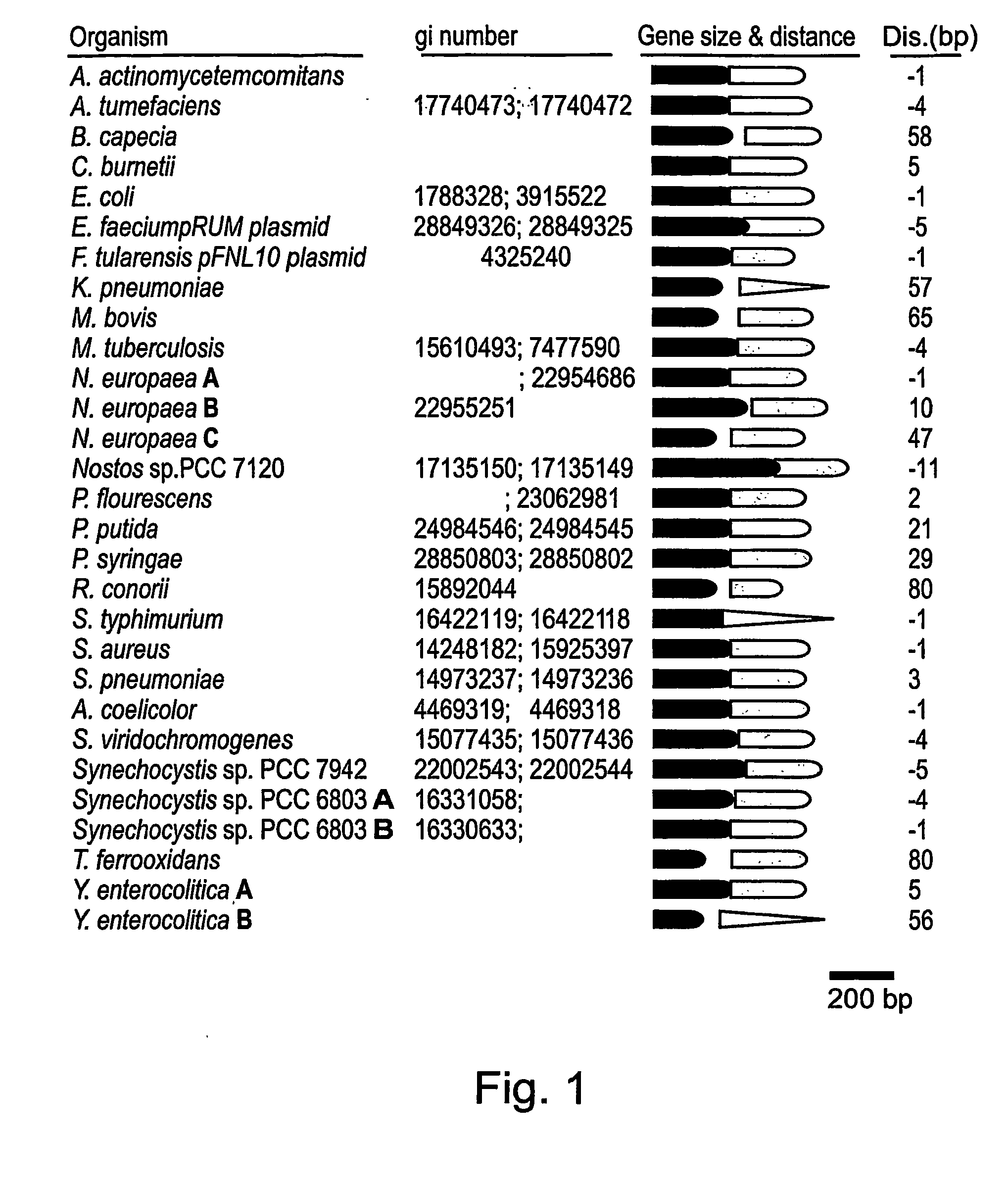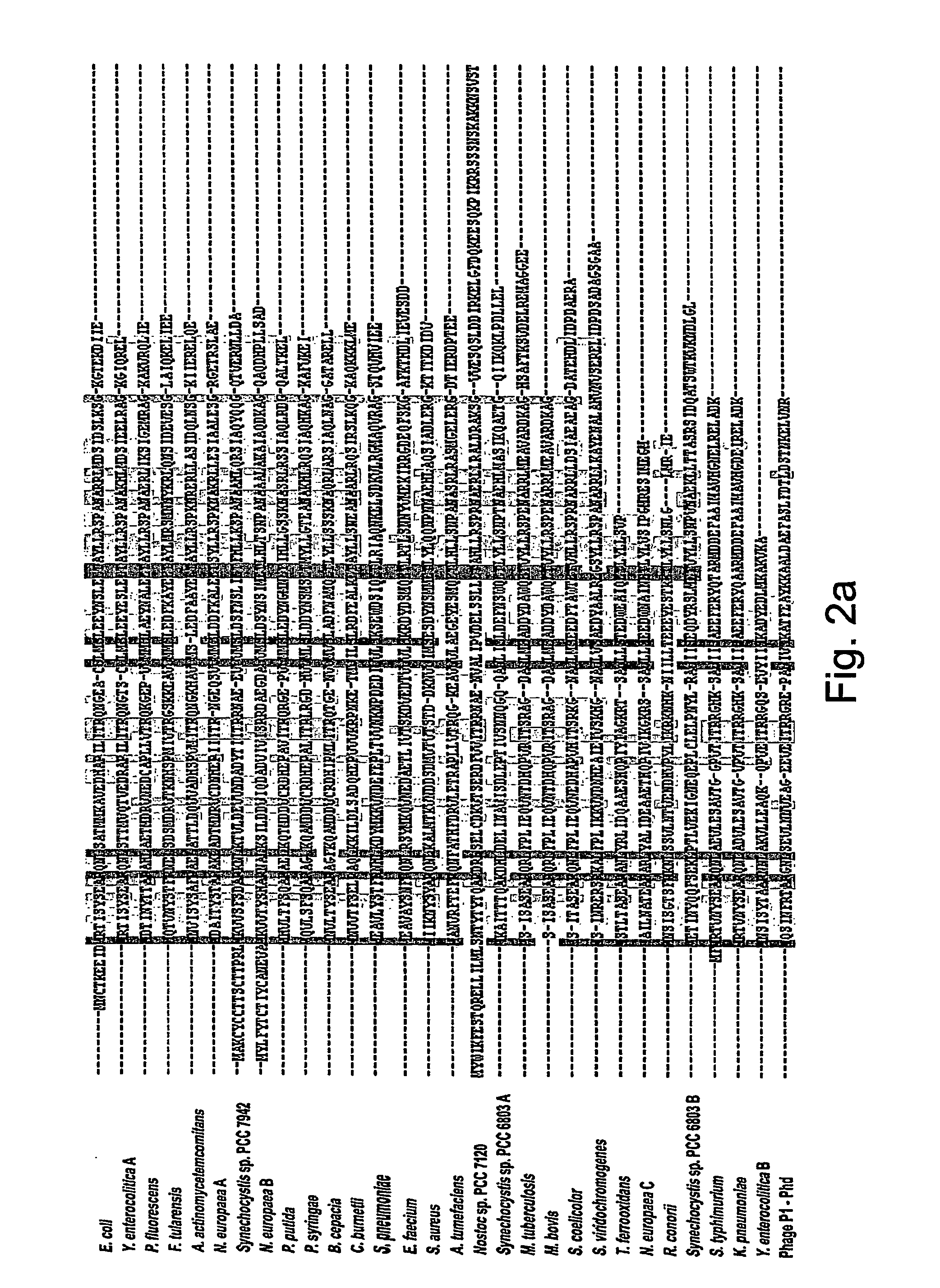Novel Antibacterial Agents and Methods of Identifying and Utilizing Same
- Summary
- Abstract
- Description
- Claims
- Application Information
AI Technical Summary
Benefits of technology
Problems solved by technology
Method used
Image
Examples
example 1
Identification of YefM and YoeB Homologue Genomic Sequences in Bacteria
[0151] Materials and Methods:
[0152] Genomic sequences related to the yefM and yoeB genes of E. coli (SEQ ID NO: 18 and 19, respectively) were identified by a pair-constrained analysis using TBLASTN and PSI-BLAST searches (20) of non-redundant microbial genomes database at NCBI (http: / / www.ncbi.nlm.nih.gov / BLAST / ). Putative yefM and yoeB homologue sequences were obtained and examined for constituting a toxin-antitoxin gene-pair module in the chromosome. Low homology unpaired sequences were discarded and pairs of genomic sequences positioned at distance of less than 100 bp were regarded as putative toxin-antitoxin systems.
[0153] Results:
[0154] Genomic sequence pairs related to yefM and yoeB were identified in 29 bacterial strains representing 13 different genera and 25 different species (FIG. 1). It is thereby demonstrated that toxin-antitoxin systems are common and widespread among bacteria and that such syste...
example 2
Sequence Alignment of YefM and YoeB Polypeptide Homologues
[0155] Materials and Methods:
[0156] Multiple alignments of translated sequences of the YefM and YoeB homologues identified in Example 1 above, were produced by CLASTAL W (21) with default settings and edited using JALVIEW editor.
[0157] Results:
[0158] Alignments of the YoeB polypeptide homologues FIG. 2B) revealed a substantially higher level of homology than was observed within the YefM and Phd family of polypeptides FIG. 2A). The relatively high degree of conservation within the YoeB homologues is well consistent with a toxic activity that explicitly targets a specific cellular determinants and that requires a well-defined fold such as a key-lock or induced fit recognition. On the other hand, the relatively low degree of conservation of YefM and Phd homologues is consistent with a polypeptide missing a clear structural recognition and / or catalytic activity that otherwise requires a defined configuration. It should be app...
example 3
Characterizing YoeB and YefM Polypeptides as a Toxin-Antitoxin Pair
[0159] Materials and Methods:
[0160] Cloning YefM, YoeB and YefM-YoeB encoding sequences into pBAD-TOPO expression vector: The encoding sequences were produced by PCR using the chromosomal DNA of E. coli strain K-12 / MC1061 as a template. The YefM encoding sequence was amplified with the primers set forth in SEQ ID NOs: 1-2. The YoeB encoding sequence was amplified with the primers set forth in SEQ ID NOs: 34. The YefM and YoeB pair encoding sequence was amplified using the primers of SEQ ID NOs: 1 and 4. The PCR products were inserted into the pBAD-TOPO vector to generate pBAD-yefM, pBAD-yoeB, and pBAD-yefMyoeB constructs using the pBAD-TOPO TA cloning kit anvitrogen). The generated constructs were introduced to E. coli strain TOP10.
[0161] Growth rate analysis: E. coli TOP10 bacteria transformed with pBAD-yefM, pBAD-yoeB, and pBAD-yefMyoeB were cultured in LB broth supplemented with 100 μg / ml ampicillin (LB-Amp) an...
PUM
| Property | Measurement | Unit |
|---|---|---|
| Antimicrobial properties | aaaaa | aaaaa |
Abstract
Description
Claims
Application Information
 Login to View More
Login to View More - R&D
- Intellectual Property
- Life Sciences
- Materials
- Tech Scout
- Unparalleled Data Quality
- Higher Quality Content
- 60% Fewer Hallucinations
Browse by: Latest US Patents, China's latest patents, Technical Efficacy Thesaurus, Application Domain, Technology Topic, Popular Technical Reports.
© 2025 PatSnap. All rights reserved.Legal|Privacy policy|Modern Slavery Act Transparency Statement|Sitemap|About US| Contact US: help@patsnap.com



